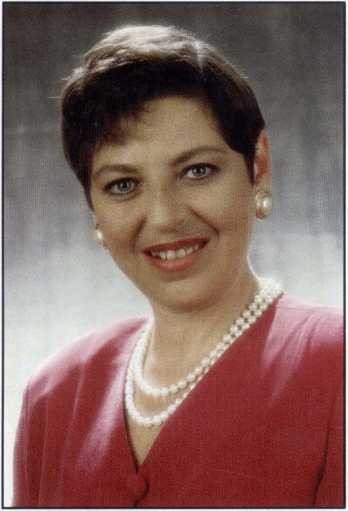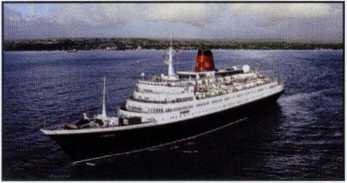 In the past, Cunard Line may not have dedicated the tonnage to the U.K. market it should have, admitted Deborah Natansohn, senior vice president of international marketing and sales – but the next few years will change all that.
In the past, Cunard Line may not have dedicated the tonnage to the U.K. market it should have, admitted Deborah Natansohn, senior vice president of international marketing and sales – but the next few years will change all that.
This May, the 736-passenger Caronia made its switch to a U.K. versus mixed passenger focus, with cruises out of Southampton. In summer 2004, the QE2 will join the Caronia in that port for U.K. – targeted voyages during the summer months. In 2005, a 1,968-passenger newbuilding will be delivered by Fincantieri, designed specifically for the British market. And that’s not to mention the 2,620-passenger Queen Mary 2, which will sell roughly half of its transatlantic capacity, and 30 percent of its annual capacity, in Great Britian.
In total, Cunard Line expects to increase capacity dedicated to the British market by 197 percent through 2005, at the same time it grows its U.S. market by 153 percent. Despite the size of those numbers, Natansohn does not count out the possibility of yet more growth plans further out.
“We feel the U.K. market is where the U.S. market was eight to 10 years ago and the potential for developing it is huge. There are a lot of opportunities out there, for many reasons.” For one, she said, “P&O is really the only other major player.” Another: “The British are more frequent vacationers than Americans. They get five weeks a year, on average, and they take it.”
She also sees opportunities in changing how the English perceive a cruise vacation. “There’s a huge potential to change the image of cruising in the same way Carnival and other brands have in the U.S.,” she said, “from something that only stodgy old people do to a vacation for all age groups.”
From a branding perspective, Natansohn explained, “We basically see P&O as being the mass market and Cunard being the premium to luxury. The new Cunarder (the 2005 newbuild) will be somewhere between premium and luxury. From the pricing point of view, the QM2 would be considered luxury in the British market – the Brits tend to be used to lower prices (than Americans).”
Asked how Cunard had modified the Caronia to fit British tastes, she answered, “Cunard has always been attuned to British sensibilities” and no hardware changes were necessary. On the software side, the onboard currency was changed to pounds sterling, the bars switched their drinks to British measures, and the entertainment lineup was changed to appeal to the English passenger base.
For the 2005 newbuild, she said, “we will be looking at the design features top to bottom in order to appeal to the Brits, from the type of alternative restaurant to the size of the casino versus the pub.” She also said there will be a much more extensive children’s program aboard the newbuild, which Cunard expects will cater to a younger clientele.
Comparing and contrasting the spending patterns of the U.K. versus U.S. market, Natansohn explained, “The U.S. passengers spend more money in the shops and in the casino. The British passengers spend more money in the bars, on shore excursions, and in the duty-free shops.”
The British also crave more sun, “being sun-deprived for so much of the year,” Natansohn said. As a result, Cunard Line’s British-oriented product will generally feature summer cruises to the Mediterranean, Baltic and Canaries. Cruises average 12 days in length, with Cunard focused on a locally homeported versus fly-cruise strategy. “Our interest is primarily in offering cruises out of Southampton, not fly- cruises, but never say never.”
 Finally, Natansohn stressed that despite the greater emphasis on the British clientele, describing Cunard as Carnival Corporation’s U.K. brand would not be accurate. Cunard is committed to growing both its American and British clientele, as well as other source markets around the world. The QE2, while being pulled from its traditional transatlantic run in 2004, “will always continue its world cruises, with passengers from the U.S., U.K., Australia, South Africa and other international markets,” she explained. And the QM2 will be devoting the majority of its non-transatlantic capacity to the American market. Among such itineraries will be N.Y.-homeported cruises to the Caribbean – a route which is becoming increasingly popular, but one where “Cunard will be able to offer more of the Caribbean than anyone else, because of the QM2’s speed,” said Natansohn.
Finally, Natansohn stressed that despite the greater emphasis on the British clientele, describing Cunard as Carnival Corporation’s U.K. brand would not be accurate. Cunard is committed to growing both its American and British clientele, as well as other source markets around the world. The QE2, while being pulled from its traditional transatlantic run in 2004, “will always continue its world cruises, with passengers from the U.S., U.K., Australia, South Africa and other international markets,” she explained. And the QM2 will be devoting the majority of its non-transatlantic capacity to the American market. Among such itineraries will be N.Y.-homeported cruises to the Caribbean – a route which is becoming increasingly popular, but one where “Cunard will be able to offer more of the Caribbean than anyone else, because of the QM2’s speed,” said Natansohn.
Even the Caronia won’t be 100 percent British. The ship is still brochured in America, she explained, “because frankly, there aren’t that many mid-sized ships out there sailing anymore, and there is definitely a market for people who like that size.”



